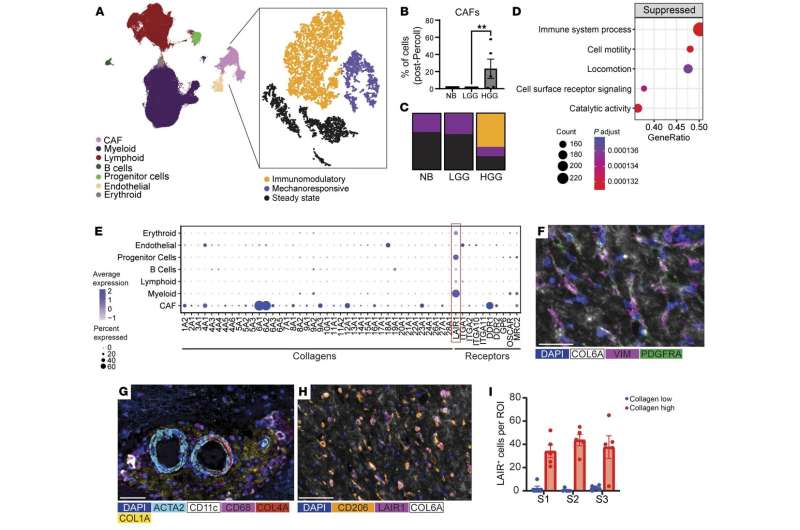This article has been reviewed according to Science X's editorial process and policies. Editors have highlighted the following attributes while ensuring the content's credibility:
fact-checked
peer-reviewed publication
trusted source
proofread
Novel immune inhibitor associated with glioma progression

Northwestern Medicine investigators led by Amy Heimberger, MD, Ph.D., the Jean Malnati Miller Professor of Brain Tumor Research and vice chair for Research in the Department of Neurological Surgery, have discovered a new mechanism in which cancer-associated fibroblasts mediate immune suppression in glioma tumors.
The findings, published in the Journal of Clinical Investigation, may also inform future immunotherapy strategies for patients who don't respond to standard treatment options.
In solid tumors, cancer-associated fibroblasts (CAFs)—cells that form connective tissue—contribute to tumor formation and growth. CAFs have been known to reside in many solid tumor cancers and form a barrier around cancer cells to prevent them from being detected by T-cells.
Recent work has shown that CAFs are also present in glioblastoma, the most common and most aggressive primary brain cancer. This discovery prompted Heimberger's team to investigate whether CAFs are a function of glioma grade or aggressiveness.
In collaboration with Michael DeCuypere, MD, Ph.D., assistant professor of Neurological Surgery in the Division of Pediatric Neurosurgery, the investigators used RNA sequencing to measure CAF frequency in low- and high-grade pediatric gliomas.
In high-grade gliomas, the investigators identified a higher frequency of a subtype of CAFs—immune modulatory cancer-associated fibroblasts.
"This study represents a unique look into the tumor microenvironment of pediatric high-grade gliomas, a previously understudied entity, and may open new avenues for immune-mediated therapy," DeCuypere said.
Multiplex staining revealed that these high-frequency CAFS were embedded in and produced collagen, which promotes tumor growth by triggering immunosuppressive mechanisms.
"These cancer-associated fibroblasts produce and are embedded in collagen, and this collagen contributes to the stiffness of the tumor," Heimberger said.
Next, by analyzing single-cell RNA sequencing data from both pediatric low and high-grade gliomas, the investigators discovered that myeloid cells express an established immunosuppressive inhibitor, the LAIR1 protein, which is a key receptor for collagen. This receptor activates an immune inhibitory signal in myeloid cells (blood cells derived from bone marrow), which are frequent in gliomas, causing the myeloid cells to become unresponsive.
According to Heimberger, the findings could inform a new immunotherapy strategy for patients who don't respond to traditional immune checkpoint inhibitors.
"Since the expression of PD-1 and PD-L1 in gliomas is very low and since these tumors do not typically respond to these types of immunotherapy, we have a new target that we can therapeutically consider," Heimberger said.
Shashwat Tripathi, a student in the Medical Scientist Training Program (MSTP), and Hinda Najem, MD, MS, a postdoctoral fellow in the Heimberger laboratory, were co-lead authors of the study.
More information: Shashwat Tripathi et al, Cancer-associated fibroblast–secreted collagen is associated with immune inhibitor receptor LAIR1 in gliomas, Journal of Clinical Investigation (2024). DOI: 10.1172/JCI176613


















